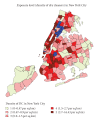Association between residential proximity to PERC dry cleaning establishments and kidney cancer in New York City
- PMID: 20169137
- PMCID: PMC2821751
- DOI: 10.1155/2009/183920
Association between residential proximity to PERC dry cleaning establishments and kidney cancer in New York City
Abstract
Perchloroethylene (PERC) is commonly used as a dry cleaning solvent and is believed to be a human carcinogen, with occupational exposure resulting in elevated rates of kidney cancer. Living near a dry cleaning facility using PERC has been demonstrated to increase the risk of PERC exposure throughout the building where the dry cleaning is conducted, and in nearby buildings. We designed this study to test the hypothesis that living in an area where there are many PERC dry cleaners increases PERC exposure and the risk of kidney cancer. We matched the diagnosis of kidney cancer from hospitalization discharge data in New York City for the years 1994-2004 by zip code of patient residence to the zip code density of dry cleaners using PERC, as a surrogate for residential exposure. We controlled for age, race, gender, and median household income. We found a significant association between the density of PERC dry cleaning establishments and the rate of hospital discharges that include a diagnosis of kidney cancer among persons 45 years of age and older living in New York City. The rate ratio increased by 10 to 27% for the populations in zip codes with higher density of PERC dry cleaners. Because our exposure assessment is inexact, we are likely underestimating the real association between exposure to PERC and rates of kidney cancer. Our results support the hypothesis that living near a dry cleaning facility using PERC increases the risk of PERC exposure and of developing kidney cancer. To our knowledge, this study is the first to demonstrate an association between residential PERC exposure and cancer risk.
Figures
References
-
- USEPA. National Emission Standards for Hazardous Air Pollutants (NESHAP) for perchloroethylene dry cleaning facilities. Final Rule. July 2006;(71 FR 4274)
-
- ATSDR. Toxicological Profile for Tetrachloroethylene. Atlanta, Ga, USA: Agency for Toxic Substances and Disease Registry; 1997. - PubMed
-
- Altmann L, Neuhann H-F, Kramer U, Witten J, Jermann E. Neurobehavioral and neurophysiological outcome of chronic low-level tetrachloroethene exposure measured in neighborhoods of dry cleaning shops. Environmental Research. 1995;69(2):83–89. - PubMed
Publication types
MeSH terms
Substances
LinkOut - more resources
Full Text Sources
Medical


